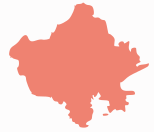Rajasthan Legislative Assembly Rajasthan Vidhan Sabha | |
|---|---|
| 16th Rajasthan Assembly | |
 | |
| Type | |
| Type | |
Term limits | 5 years |
| Leadership | |
Haribhau Kisanrao Bagde since 27 July 2024 | |
Vasudev Devnani Since 21 December 2023 | |
Leader of the House (Chief Minister) | |
Deputy Chief Minister (Deputy Leader of the House) | |
| Structure | |
| Seats | 200 |
 | |
Political groups | Government (129)
Other Opposition (4)
Vacant (1)
|
| Elections | |
| First past the post | |
Last election | 25 November 2023 |
Next election | 2028 |
| Meeting place | |
 | |
| Vidhan Bhavan, Jaipur, Rajasthan, India | |
| Website | |
| Rajasthan Legislative Assembly | |
The Rajasthan Legislative Assembly, also known as the Rajasthan Vidhan Sabha, is the unicameral legislature of the state of Rajasthan. It is a vital part of the state government, responsible for making and implementing laws.
Contents
The assembly meets at Vidhan Bhavan situated in Jaipur, the capital of Rajasthan.
